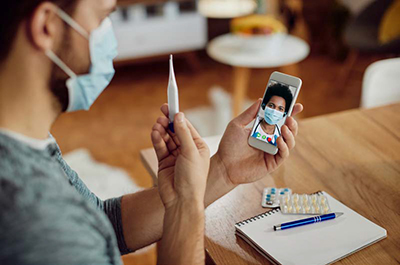Telehealth encompasses a wide range of electronic and telecommunications technologies, offering remote healthcare services, information, and education. While face-to-face encounters remain necessary in certain cases, telemedicine complements in-person visits by utilizing virtual technologies like video conferencing, reducing medical visits, improving workflow efficiency, and facilitating post-discharge monitoring.

Telehealth — sometimes called telemedicine — allows healthcare providers to deliver care remotely without requiring an in-person visit. The terms telehealth and telemedicine are often used interchangeably, but they do have some important distinctions. Telehealth is a broad collection of electronic and telecommunications technologies and has a wider range of remote healthcare services than telemedicine in healthcare delivery, information, and education. Both telehealth and telemedicine offer similar services, such as medical education, remote patient monitoring, videoconferencing consultations with patients, wireless health applications, and transmission of medical reports and images. However, while telemedicine focuses solely on remote clinical services, telehealth encompasses remote non-clinical services such as healthcare provider training, continuing medical education or public health education for providers, administrative meetings, provider-to-provider communication, and electronic information sharing to facilitate and support assessment, diagnosis, consultation, treatment, education, and care management.
Initially, the original concept of telehealth was to offer fundamental care to patients in remote and underserved areas. Wider acceptance and integration of telehealth into modern healthcare systems can be attributed to various factors. Notably, the transition of health care from fee-for-service models to models in which reimbursement is linked to patient and quality outcomes is one such factor. With increasing emphasis on providing quality patient care and cutting costs, telehealth has benefits and success being witnessed across various medical specialties and settings. Telehealth provides patients with a broad range of medical services, including lab tests or X-ray results, mental health treatment, prescription management, and follow-up appointments for chronic conditions like migraines, urinary tract infections, and skin conditions. Additionally, it offers physical therapy and occupational therapy, post-surgical follow-up, treatment and follow-up appointments, and urgent care issues such as colds, coughs, and stomach aches. With remote monitoring services, patients can manage their health goals and chronic conditions like diabetes, high blood pressure, and high cholesterol.
With the progress of mobile and electronic technologies, telemedicine has become increasingly accessible. As per the findings of a 2019 report published by the Pew Research Center, 90% of Americans utilize the Internet. Additionally, approximately 81% of Americans own a smartphone, almost 75% own desktop or laptop computers, and nearly 50% own tablet computers or e-readers. The increased availability of mobile technologies has played a vital role in the advancement of telemedicine.
The use of telemedicine has been experiencing a swift rise in the United States. According to reports, the percentage of US hospitals utilizing video and other technologies to connect with patients has increased from 35% to 76% between 2010 and 2017. Telemedicine in the United States experienced a significant peak in April 2020, during the initial surge of COVID-19 cases, when it accounted for an impressive 69% of all doctor-patient visits.
Amidst the COVID pandemic, telemedicine has demonstrated immense potential in enhancing patients' access to quality and affordable healthcare while ensuring the safety of healthcare providers and patients by maintaining physical distancing measures. Telemedicine provides the convenience of avoiding the hassle of driving to a doctor's office or clinic, finding a parking spot, walking or waiting in a crowded room when you're unwell. Instead, you can consult with your doctor from the cozy comfort of your own bed or couch. Virtual visits also offer flexibility in scheduling, making finding a time that works for you easier. This flexibility can save you the trouble of taking time off from work or arranging for childcare, depending on your schedule.

Issues like limited internet connectivity and the absence of Wi-Fi and video chat/webcam capabilities in both urban and rural regions can impede the full potential of telehealth, particularly among communities of color, the impoverished, and medically underserved populations. According to the Federal Communications Commission (FCC) and other sources, an estimated 21 to 42 million Americans lack access to high-speed internet. The digital divide has further aggravated the social and economic factors that hinder healthcare delivery and overall well-being. A study revealed that metropolitan areas had approximately 50 telemedicine visits per 10,000 individuals, while rural areas had around 31 visits per 10,000 individuals. Moreover, counties with low poverty levels had about 48 telehealth visits per 10,000 individuals, compared to only 15 visits per 10,000 individuals in high-poverty areas.
Telehealth plays a crucial role in promoting health equity by ensuring that all individuals, irrespective of their social or economic background, have access to the healthcare they require and deserve. Achieving health equity in telehealth necessitates addressing issues related to digital literacy, technology, and analytics. Achieving health equity in telehealth involves addressing the needs of underserved communities, including low-income individuals, rural residents, people of color, immigrants, people with disabilities, older patients, and those with limited English proficiency or digital literacy. These communities often face barriers to healthcare access, resulting in higher mortality rates, increased disease burden, and limited treatment options. Limited access to technology, internet connectivity, suitable physical spaces for virtual visits, local telehealth providers, language barriers, and lack of adaptive equipment for disabilities are common obstacles to telehealth access. Overcoming these limitations requires interventions in digital literacy, technology, and analytics to ensure equitable healthcare delivery for all.
Telehealth has some drawbacks, including limitations with comprehensive physical examinations, possibilities for technical difficulties, security breaches, and regulatory barriers. When compared to in-person visits, telemedicine visits are more prone to privacy and security risks. While most telehealth systems follow strict encryption and abide by the Health Insurance Portability and Accountability Act regulations, no platform is 100% safe from hackers or data breaches.
What are the current trends and future prospects for telehealth, considering its origin and historical trajectory?
Telehealth is a promising tool for public health, offering potential benefits like increasing access to care, improving patient-physician relationships, and saving healthcare costs. While face-to-face encounters remain necessary in some situations, telemedicine can supplement in-person visits by reducing medical visits through virtual technologies like video conferencing. Its efficiency also streamlines workflows, making managing recovery and monitoring discharged patients easier. At the end of the day, the utilization of technology is more integrated now than ever before. Furthermore, innovations in remote sensing technologies, patient education and improvement in health literacy, and practice adoption will continue to shape this growing trend. All in all, telemedicine offers a mutually beneficial situation for patients and healthcare providers.
References
1. https://telehealth.hhs.gov/patients/understanding-telehealth
2. https://www.cdc.gov/phlp/publications/topic/telehealth.html
3. https://www.ncbi.nlm.nih.gov/pmc/articles/PMC7437610/
4. https://www.goodrx.com/healthcare-access/telehealth/telehealth-vs-telemedicine
5. https://www.ncbi.nlm.nih.gov/pmc/articles/PMC7577680/
6. https://www.aafp.org/about/policies/all/telehealth-telemedicine.html
7. https://hbr.org/2022/05/the-telehealth-era-is-just-beginning
8. https://journals.plos.org/plosone/article?id=10.1371/journal.pone.0269264
9. https://www.hopkinsmedicine.org/health/treatment-tests-and-therapies/benefits-of-telemedicine
10. https://www.sciencedirect.com/science/article/pii/S2666351121000383
11. https://telehealth.hhs.gov/providers/health-equity-in-telehealth
12. https://www.axios.com/2021/03/16/telehealth-health-equity-problem